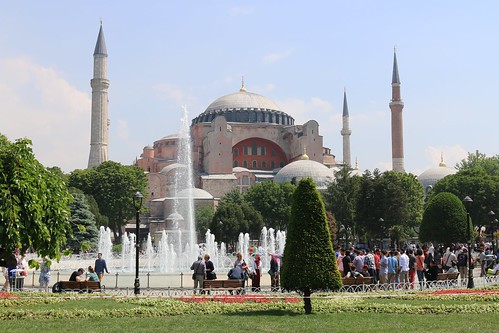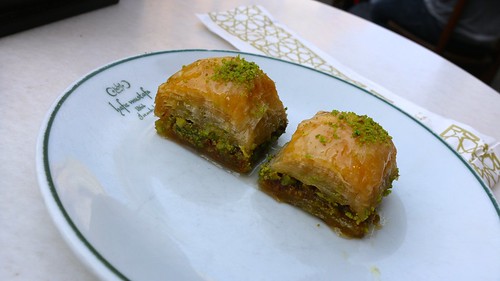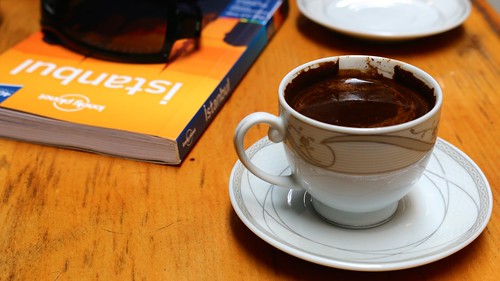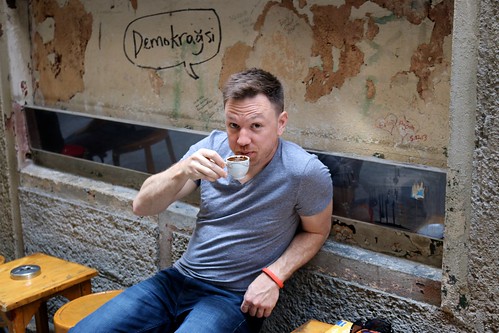Turkish Coffee with a side of Quake at Mandabatmaz in Istanbul
By Ryan Snyder, 12 June 2014
I recently spent my 38th birthday in Istanbul. It’s an overwhelming, yet amazing city where east meets west; where Europe meets Asia; where Christianity meets Islam. 14 million people live in Istanbul; 65% on the European side, and 35% on the Asian side.
In the past it’s been called Byzantium and Constantinople, and has been the capital of four different empires - the Roman Empire, the Byzantine Empire, the Latin Empire and the Ottoman Empire. In 330 AD the city was converted to Christianity, and in 1453 AD it was converted to Islam. When you stand in the Hagia Sofia, both religions are everywhere you look. Islamic calligraphy hangs high above in the temple, coexisting with recently uncovered tiled murals of Jesus and other notable Christian figures. The temple was originally constructed so that the building’s center window faces to the southeast, while the mihrab points 9 degrees further to the south so that it points towards Mecca.
Turkey is also home of the North Anatolian Fault Zone, which is where the Eurasian plates meet the Anatolian plates. The fault runs along the northern border of Turkey, cuts about 20 miles south of Istanbul, and extends into the Aegean Sea. It's basically the equivalent of the San Andreas Fault in California. It causes frequent earthquakes, some of a serious magnitude, and scientists are always trying to predict when the big one will hit.
When I travel, I often do so by following my belly’s lead. Before any trip I spend hours reading through blogs and articles to determine which foods I need to devour when I arrive. For Istanbul, the concise list of foods and beverages I had to consume included baklava, kebaps, the Turkish variant of pizza called pide, a beef sausage called sucuk, and Turkish coffee.
I quickly found that Istanbul is also where coffee meets tea. Or, maybe it's more appropriate to say where tea had completely overtaken coffee as the Turkish drink of choice. The Turks were drinking tea as if they were trying to out-consume both the Chinese and the Brits. Shopkeepers in the Grand Bazaar invite you into their store to barter over glasses of çay, and after every meal the server asks if you'd like tea, not coffee, before heading off into the night. But it hasn't always been that way.
Back in the 1530s, the Ottomans drove south and overtook the country of Yemen. There were two reasons for doing so - it allowed the Ottoman Empire to better protect Mecca (the Islamic holy city in modern day Saudi Arabia) and the spice trade route to India. The added benefit was that Yemen was one of the few coffee producing countries at that time, and the Ottomans established a monopoly on coffee. Istanbul's first coffeehouses arose in the 1550s, and it became the beverage used in rituals throughout the Ottoman Empire.
Turkish coffee is made by pulverizing roasted coffee beans into a fine powder using a mortar and pestle. The grounds are then boiled with water and sugar in a cezve, a small copper pot with a long handle attached to its top, over hot coals. Once boiled, the kahve is served as a thick foam in a demitasse, where the grounds settle to the bottom of the cup as you drink it.
Every blog post, article, and travel guide I’ve read said the best Turkish coffee in Istanbul could be found at Mandabatmaz. Mandabatmaz is a tiny cafe in Beyoğlu, the international district of Istanbul, just off the main shopping street of Istiklal Avenue. Outside the cafe, the building is lined with tables sitting low to the ground surrounded by squat stools. Across the alley, shelves are screwed into the side of the building for those who prefer to take their coffee standing up.
When we sat down, a young Turk asked for our order. My girlfriend and I ordered two Turkish coffees. The options for the coffees were, he offered, “No sweet, little sweet, or very sweet.” “Little sweet,” we said. He popped into the shop; five minutes later he set the porcelain cups down on our table. Normally the liquid sloshes around in its container, but the black liquid in these cups was so thick that it barely moved.
I took a sip - it was the consistency of an Italian drinking chocolate, but with a slight grittiness to it, as if the innards of 3 vanilla bean pods had each been scraped into the liquid. I took another sip, enjoying the slightly sweet and bitter sensations with a hint of cardamom, and my newfound state of bliss. I took a third sip, and while chewing the beverage, the Turkish men at each of the tables stood up and began shouting. I took another sip, and watched them look to the sky, and pointing upwards, still shouting. I took another sip, and my girlfriend said to me, “Did you feel that? I think that was an earthquake.” “What?” I asked - still chewing - oblivious to what was going on.
The late 50s-barista and the servers walked out to the alley, looking up, and I too looked up — business signs swayed 6 inches side-to-side without a breeze in the air. “Maybe you’re right,” I said to her. “That was definitely an earthquake,” she responded. I took another sip, hitting the grounds at the bottom of the cup, and realized I’d just sat through an earthquake (a 6.4 magnitude quake centered in the neighboring Aegean Sea), and didn’t feel a damn thing. Sitting here, chewing the best Turkish coffee I’ve ever tasted, to me the world has never felt more in balance.





